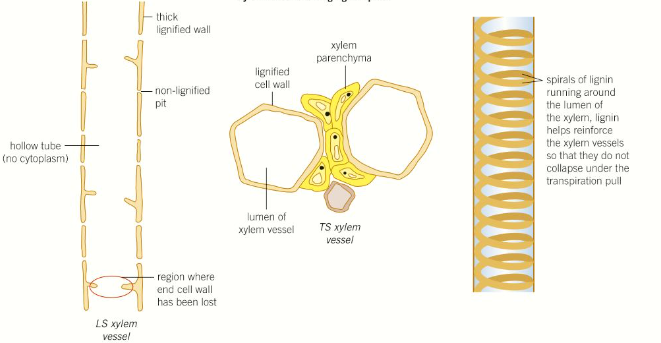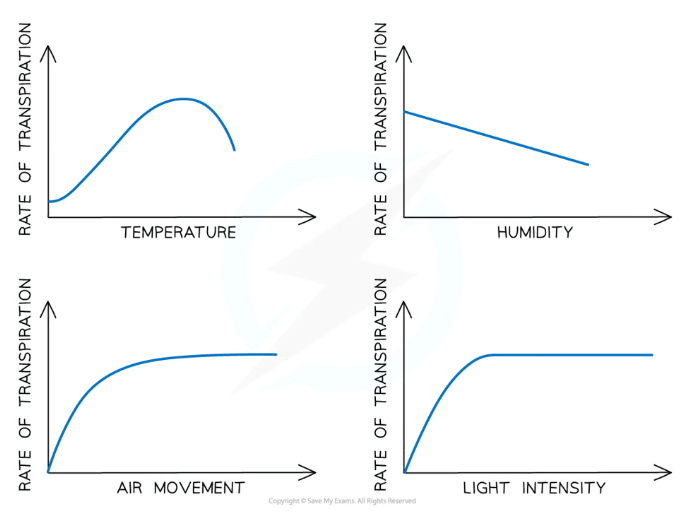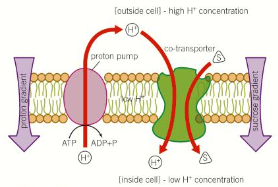Biology 3.1.3- Transport in Plants
1/18
There's no tags or description
Looks like no tags are added yet.
Name | Mastery | Learn | Test | Matching | Spaced |
|---|
No study sessions yet.
19 Terms
What is the structure of the vascular bundles in leaves, stems and roots?
(The white layer between the xylem and phloem in the stem is the cambium layer, which is a type of meristem)

What is the function of xylem and phloem?
Xylem:
The transport of water and dissolved minerals around the plant by transpiration
Structural support
Phloem:
The transport of dissolved sugars up and down the plant by translocation
What is the structure of xylem tissue?
Xylem vessel elements: dead cells, with cell walls that contain lignin spirals, that join up and lose their end walls to form a hollow tube for water transport
Xylem parenchyma: packed around the vessel cells, storing food and tannins
Xylem fibres: lignified cells that provide mechanical strength (don’t transport water)

What is the structure of phloem tissue?
Sieve tube elements: living cells that join up to form a tube with little cytoplasm and few organelles, with pores in the end walls to transport dissolved sugars
Companion cells: load and unload sugars into the phloem by active transport and provides support for sieve tube metabolism
What is the process of transpiration, from water in the soil to the air?
Water moves from the soil into the root hair cells by osmosis (from a high to low water potential)
It diffuses through the apoplastic pathway (through the cell walls), which is faster, or the symplastic pathway (through the cytoplasm) to the xylem
Water is drawn up through the xylem by the cohesion of the transpiration stream
It reaches the leaves, and evaporates out through the stomata by diffusion
What happens to water in the apoplastic pathway in roots when it reaches the xylem?
Water can’t diffuse into the xylem through the apoplastic pathway because of a waxy, waterproof band of suberin in the cell walls near the xylem called the Casparian strip
This means the water must enter the symplastic pathway at that point and travel by osmosis from the cytoplasm across the cell membrane into the xylem
This is thought to help control what can enter the xylem and block certain substances
Why is water drawn up through the xylem?
The continuous evaporation of water out the leaves through stomata pulls more water up the xylem due to the cohesive and adhesive properties of water molecules (they stick together)- this is called transpiration pull
Mineral ions are drawn into the roots by active transport, which lowers the water potential, causing more water to travel in by osmosis, which generates pressure that forces water up the xylem (particularly at night when the stomata are closed and the transpiration pull is decreased)- this is called root pressure
How do stomata work?
Stomata are small holes made by pairs of guard cells
When the stomata are open, there is a greater rate of gaseous exchange (of CO2 in and O2 out) and transpiration
In the day, the guard cells are turgid due to a higher rate of photosynthesis, so they open (due to having a thicker inner wall)
At night, the guard cells are flaccid, so they close
What factors affect the rate of transpiration and how?
Air movement- wind moves water vapour away from the leaf when it evaporates, which maintains a steep concentration gradient to increase the rate of diffusion and transpiration
Temperature- higher temperatures gives particles more kinetic energy, so they move faster and increase the rate of diffusion and transpiration
Light intensity- in the light, photosynthesis increases, so more stomata open, increasing the rate of diffusion and transpiration
Humidity- high humidity decreases the concentration gradient as there are more water molecules in the air, which decreases the rate of diffusion and transpiration

How can we estimate the rate of transpiration?
Using a potometer

What are assimilates?
The resources plants need that are transported through the phloem (mainly sucrose)
What are the source and sink?
Source- where assimilates are produced or stored
Sink- where assimilates are transported to be used
The season and the growth stage the plant is in decides wich organs/tissues are the sources and sinks
The sources tend to be the leaves (where glucose is produced in photosynthesis), and the sinks tend to be the roots (where photosynthesiss can’t occur), or at the meristem (where growth is fastest)
What is the process of assimilate loading in the phloem?
Symplast (cytoplasm) route:
The assimilates diffuse passively (down concentration gradient) through the cytoplasm of cells into sieve tubes by plasmodesmata
Apoplast (cell wall) route:
The assimilates diffuse passively through the cell wall and intermembrane spaces
When they reach the companion cells, they have to be transported across the membrane manually (in the diagram):
Hydrogen ions are actively pumped out (requiring ATP) of the companion cells, producing a concentration gradient
In order to diffuse back into the companion cells down the concentration gradient, they have to bind to sucrose molecules to get back through co-transporter proteins
Then they can diffuse into the sieve tubes

What is the mass flow hypothesis of the translocation mechanism in the phloem?
At the source, sucrose enters the sieve tube element from the companion cells, which decreases the water potential
Water follows by osmosis down the water potential gradient, which increases the hydrostatic pressure
Water and sucrose move down the sieve tube from a high to low hydrostatic pressure at the sink
At the sink, sucrose diffuses into the cells, which increases the water potential
Water follows by osmosis, which decreases the hydrostatic pressure, retaining the ‘pressure gradient’ from source to sink

What are xerophytic plants?
Plants that live in and are adapted to dry conditions, eg:
Cacti
Marram grass
They have adaptations to maximise water conservation
What are hydrophytic plants?
Plants that live in and are adapted living in water, eg:
Water lillies
They have adaptations to maximise oxygen and carbon dioxide uptake (excess water uptake is not an issue as they have cell walls)
What are mesophytic plants?
‘Regular’ plants- don’t live in extreme conditions and so don’t need special adaptations to meet water, oxygen or carbon dioxide demands
What are some adaptations of xerophytic plants?
Only a few thick, fleshy leaves- stores water, low surface area : volume ratio reduces water evaporation
Sunken stomata/hairs on leaf surface- traps moist air near the stomata to reduce the water potential gradient and decrease diffusion
Fewer stomata- less water can diffuse out
Thick waxy cuticle- less water escapes through epidermis
Hinge cells- cells that shrink when flaccid (lacking water) and make the leaf roll up so that stomata are in a humid space inside (eg. in marram grass)
Stomata that only open in the night- exchange gases at night and store carbon dioxide until it is needed, so the stomata aren’t open in the day when transpiration rates are high
Tap roots/wide root systems- tap roots go very deep to reach water far underground, wide, shallow root systems absorb rain water in a large area before it evaporates
What are some adaptations of hydrophytic plants?
Wide, flat leaves- high surface area fro photosynthesis
Air spaces in leaves- buoyancy makes the leaves float, keeping them at the surface of the water to increase light intensity and gas uptake
Thin waxy cuticle- not needed to prevent water loss
Stomata in the upper epidermis- stomata are exposed to the air to increase gas exchange (eg. in water lillies)
Stomata that are always open- allows for gas exchange at any time when water loss from transpiration is not an issue
Small root system- water can be taken in through tissues, so large root systems aren’t required
Less xylem- less need for water transport around the plant, and not needed for structural support as it is supported by the water